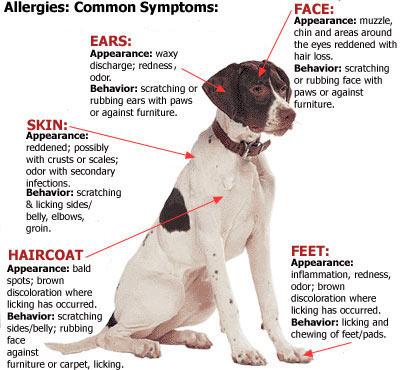
In people, food allergy symptoms usually include a tingly sensation and a itching of the throat. For pets, food allergy symptoms include itchy skin, chronic ear infections, and frequent hot spots, as well as the licking and chewing on feet. If your pet shows any of these symptoms, it’s a good time to reevaluate what you’re feeding. After all, May is Food Allergy Action month. Your veterinarian can run tests on your pet but it can be tough to pinpoint the exact allergy triggers simply because allergies develop over time. You can feed your pet the same food for years but when you notice him chewing his paws or random hot spots, it’s time to take a look at his diet.
What Causes Food Allergies?
Medical professionals say allergies are triggered as a result of the body’s immune system going into overdrive. Essentially, your pet eats something that his body “thinks” is a problem and overwhelms the body with chemicals to “fix” it. It’s a hypersensitivity to the food source. Proteins like chicken and beef as well as wheat or gluten are common allergens for dogs. These food allergies typically develop over time which is why your pet can be eating the same food for years and then start displaying the symptoms. That makes it tricky for both uncovering the exact trigger as well as treating it.
How to Treat for a Food Allergy
You may have heard of the elimination diet. Just like it sounds, you eliminate everything you can from your pet’s diet and try a new food.
For example, you can try a food that includes a protein that your pet has never eaten. These are often called “novel proteins” – Venison, bison and lamb often fall into this category. You may also want to avoid wheat & grains in your pet’s food and treats by checking out grain-free recipes. Holistic Select offers grain-free recipes.
Choose a food your pet has never eaten with a different protein source – for example, if your pet usually eats chicken based food, choose salmon. Make sure your pet’s treats fit within the new approach as well. Make sure everyone in the family is on board with this test. If anyone is sneaking your pet treats or people food that’s not on the diet, you won’t have a pure test.
- Allow enough time, it can take 10 – 18 weeks to see a difference
- Keep a notebook – times that you feed your pet, any reactions (or not), write it all down.
- You may have to try this more than once, each time eliminating a protein source, or a grain or other ingredients you find common. --Proteins and wheat are the typical triggers so it makes sense to start there.
- If you keep notes about the food you feed, then you’ll have an easier time distinguishing if your pet’s symptoms improve or worsen.
We hope you find a solution. Check out Holistic Select’s offerings of dry and wet food that contain different proteins and are available in grain-free options.